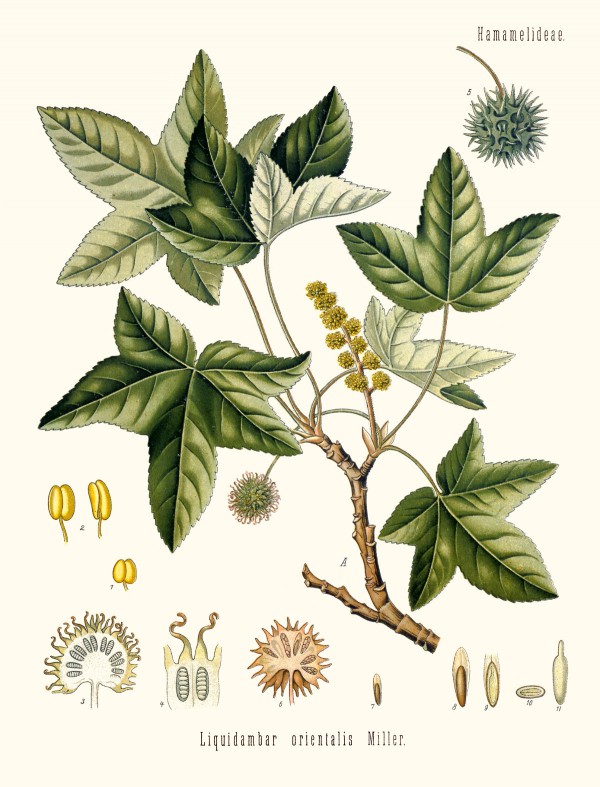Liquidambar orientalis Mill. - Hamamelidaceae - Oriental sweet-gum, Levant storax, Orientalischer Amberbaum, Levantischer Styrax
Deciduous tree, up to 15m high, native to the eastern Mediterranean region.
„The name in Turkish for the particular species is Günlük ağacı, while the trees of the genus as a whole are called Sığala ağacı, a name also used in sole reference to oriental sweeetgum itself. Günlük ağacı means “a frankincense/myrrh tree [ağaç]” in which the first element is of unknown origin, whereas sığala refers to “a boggy place”… The extraction of its sap and the production of an oil based thereof (sığala yağı), as well as exports of these products, play an important role in the local economy… The stripped sap is put in boiling water to soften, then pressed. The styrax is then diluted with ¼ water, keeping it soft and preserving its aroma. By steam destillation a light yellow oil is obtained, which can be used for medical applications.“ http://en.wikipedia.org/wiki/Liquidambar_orientalis
„Threats to extinction: The forests of L. orientalis have been severely destroyed during the last 200 years. This disappearance has started the chain of events leading to an extinction of many other species. Unfortunately, the landscape is becoming increasingly fragmented leading towards a loss of too many species, which means a psychological and spiritual loss too… The area of this taxon has got reduced from 7000 to 1657.80 ha during the last 200 years. Major anthropogenic impacts involved in the decline of this important genetic heritage are habitat destruction due to cutting and felling for wood, followed by a change of the land use, grazing, resin extraction and urban development pressures.“ http://isebindia.com/01_04/04-10-3.html
The major components of the essential oil from Asian styrax gum were styrene (70.4%), α-pinene (19.4%) and β-caryophyllene (0.2%).
[Chemical composition of the essential oils from Turkish and Honduras Styrax., Fernandez, X., Lizzani‐Cuvelier, L., Loiseau, A.M., Perichet, C., Delbecque, C., Arnaudo, J.F., Flavour and fragrance journal, 20(1), 2005, 70-73]
Main components of a commercial sample of the essential oil from L.orientalis were (E)-cinnamyl alcohol (45%) and hydrocinnamyl alcohol (41%). Minor constituents are β-caryophyllene (3%), styrene (1.5%), benzyl alcohol (1.2%), α-pinene (1%) and benzaldehyde (0.4%).
[Nematicidal activity of plant essential oils and components from coriander (Coriandrum sativum), oriental sweetgum (Liquidambar orientalis), and valerian (Valeriana wallichii) essential oils against pine wood nematode (Bursaphelenchus xylophilus). Kim, J., Seo, S. M., Lee, S. G., Shin, S. C., Park, I. K., Journal of agricultural and food chemistry, Vol.56(16), 2008, 7316-7320]
Styrax, resin of Liquidambar orientalis Mill., „… belongs to resuscitation-inducing aromatic herbs in traditional Chinese medicine and functions in inducing resuscitation and restoring conscientiousness… Styrax has sedative and anticonvulsant activities in mice, .. (especially) after intranasal administration.“
[Sedative and anticonvulsant activities of styrax after oral and intranasal administration in mice. Guo, J., Duan, J. A., Tang, Y., Li, Y., Pharmaceutical Biology, Vol.49(10), 2011, 1034-1038]
„Pharmacological experiments have clearly demonstrated that 150 and 300 mg/kg doses of Styrax liquidus given orally to rats showed significant gastric protection. On GC-MS analysis of the resin, overall, 31 compounds representing 99.8% of the total oil were identified where styrene (81.9%), cinnamyl alcohol (6.9%) and α-pinene (3.5%) were identified as the major components.“
[Gurbuz, Ilhan, et al. „Characterization of volatiles and anti-ulcerogenic effect of Turkish sweetgum balsam (Styrax liquidus).“ Journal of ethnopharmacology 148.1 (2013): 332-336]

Köhler,F.E., Medizinal Pflanzen, vol.2 t.101 (1890)
http://plantgenera.org/species.php?id_species=611243
Liquidambar orientalis, Schlosspark Schönbrunn
© Rolf Marschner (2010),
www.botanische-spaziergaenge.at





